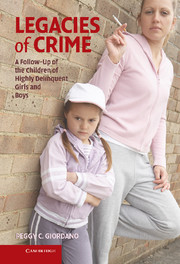Crossref Citations
This Book has been
cited by the following publications. This list is generated based on data provided by Crossref.
GIORDANO, PEGGY C.
LONARDO, ROBERT A.
MANNING, WENDY D.
and
LONGMORE, MONICA A.
2010.
ADOLESCENT ROMANCE AND DELINQUENCY: A FURTHER EXPLORATION OF HIRSCHI'S “COLD AND BRITTLE” RELATIONSHIPS HYPOTHESIS*.
Criminology,
Vol. 48,
Issue. 4,
p.
919.
Pasko, Lisa
and
Chesney-Lind, Meda
2010.
Under Lock and Key: Trauma, Marginalization, and Girls' Juvenile Justice Involvement.
Justice Research and Policy,
Vol. 12,
Issue. 2,
p.
25.
2010.
Publications Received.
Contemporary Sociology: A Journal of Reviews,
Vol. 39,
Issue. 4,
p.
508.
WILDEMAN, CHRISTOPHER
2011.
Commentary on Roettger et al. (2011): Confronting the elephant in the room.
Addiction,
Vol. 106,
Issue. 1,
p.
133.
Kruttschnitt, Candace
2011.
Is the devil in the details?.
Criminology & Public Policy,
Vol. 10,
Issue. 3,
p.
829.
Hissel, Sanne
Bijleveld, Catrien
and
Kruttschnitt, Candace
2011.
The well-being of children of incarcerated mothers: An exploratory study for the Netherlands.
European Journal of Criminology,
Vol. 8,
Issue. 5,
p.
346.
ROETTGER, MICHAEL E.
and
SWISHER, RAYMOND R.
2011.
ASSOCIATIONS OF FATHERS' HISTORY OF INCARCERATION WITH SONS' DELINQUENCY AND ARREST AMONG BLACK, WHITE, AND HISPANIC MALES IN THE UNITED STATES*.
Criminology,
Vol. 49,
Issue. 4,
p.
1109.
Kolar, Katarina
2011.
Resilience: Revisiting the Concept and its Utility for Social Research.
International Journal of Mental Health and Addiction,
Vol. 9,
Issue. 4,
p.
421.
Estrada, Felipe
and
Nilsson, Anders
2012.
Does It Cost More to Be a Female Offender? A Life-Course Study of Childhood Circumstances, Crime, Drug Abuse, and Living Conditions.
Feminist Criminology,
Vol. 7,
Issue. 3,
p.
196.
Frost, Natasha A.
and
Clear, Todd R.
2012.
New Directions in Correctional Research.
Justice Quarterly,
Vol. 29,
Issue. 5,
p.
619.
CARBONE‐LOPEZ, KRISTIN
and
MILLER, JODY
2012.
PRECOCIOUS ROLE ENTRY AS A MEDIATING FACTOR IN WOMEN'S METHAMPHETAMINE USE: IMPLICATIONS FOR LIFE‐COURSE AND PATHWAYS RESEARCH*.
Criminology,
Vol. 50,
Issue. 1,
p.
187.
TURANOVIC, JILLIAN J.
RODRIGUEZ, NANCY
and
PRATT, TRAVIS C.
2012.
THE COLLATERAL CONSEQUENCES OF INCARCERATION REVISITED: A QUALITATIVE ANALYSIS OF THE EFFECTS ON CAREGIVERS OF CHILDREN OF INCARCERATED PARENTS*.
Criminology,
Vol. 50,
Issue. 4,
p.
913.
Swisher, Raymond R.
and
Roettger, Michael E.
2012.
Father's Incarceration and Youth Delinquency and Depression: Examining Differences by Race and Ethnicity.
Journal of Research on Adolescence,
Vol. 22,
Issue. 4,
p.
597.
Wildeman, Christopher
and
Muller, Christopher
2012.
Mass Imprisonment and Inequality in Health and Family Life.
Annual Review of Law and Social Science,
Vol. 8,
Issue. 1,
p.
11.
Carbone-Lopez, Kristin
Owens, Jennifer Gatewood
and
Miller, Jody
2012.
Women’s “Storylines” of Methamphetamine Initiation in the Midwest.
Journal of Drug Issues,
Vol. 42,
Issue. 3,
p.
226.
MURRAY, JOSEPH
LOEBER, ROLF
and
PARDINI, DUSTIN
2012.
PARENTAL INVOLVEMENT IN THE CRIMINAL JUSTICE SYSTEM AND THE DEVELOPMENT OF YOUTH THEFT, MARIJUANA USE, DEPRESSION, AND POOR ACADEMIC PERFORMANCE*.
Criminology,
Vol. 50,
Issue. 1,
p.
255.
Gunter, Whitney D.
Kurtz, Steven P.
Bakken, Nicholas W.
and
O’Connell, Daniel J.
2012.
Desisting From Prescription Drug Abuse.
Journal of Drug Issues,
Vol. 42,
Issue. 1,
p.
82.
Roettger, Michael E.
and
Boardman, Jason D.
2012.
Parental Incarceration and Gender-based Risks for Increased Body Mass Index: Evidence From the National Longitudinal Study of Adolescent Health in the United States.
American Journal of Epidemiology,
Vol. 175,
Issue. 7,
p.
636.
Turney, Kristin
Schnittker, Jason
and
Wildeman, Christopher
2012.
Those They Leave Behind: Paternal Incarceration and Maternal Instrumental Support.
Journal of Marriage and Family,
Vol. 74,
Issue. 5,
p.
1149.
Wildeman, Christopher
Schnittker, Jason
and
Turney, Kristin
2012.
Despair by Association? The Mental Health of Mothers with Children by Recently Incarcerated Fathers.
American Sociological Review,
Vol. 77,
Issue. 2,
p.
216.



